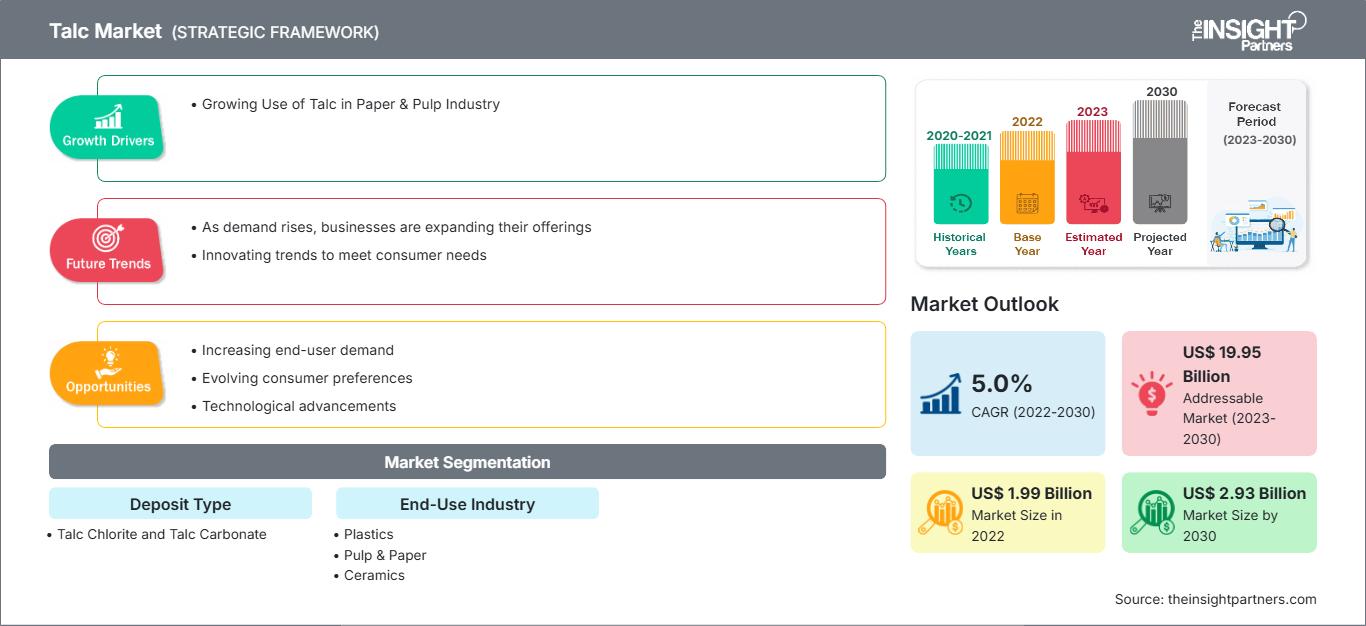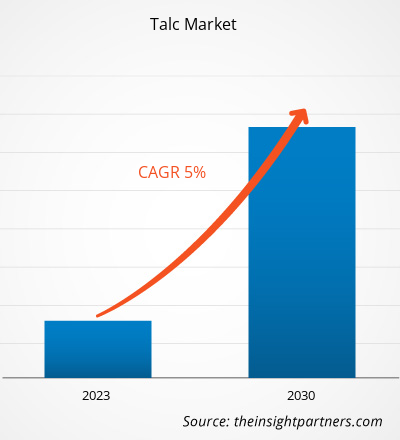[Forschungsbericht] Der Talkmarkt soll von 1.987,43 Millionen US-Dollar im Jahr 2022 auf 2.932,29 Millionen US-Dollar im Jahr 2030 wachsen; von 2022 bis 2030 wird eine durchschnittliche jährliche Wachstumsrate (CAGR) von 5,0 % erwartet.
Markteinblicke und Analystenmeinung:
Talk ist ein hydratisiertes Magnesiumsilikat. Talkvorkommen entstehen durch die Umwandlung magnesiumreicher Gesteine durch kieselsäurehaltige hydrothermale Flüssigkeiten. Der Großteil des Talks entsteht durch die Alteration von Dolomit oder ultramafischen Intrusivgesteinen. Er kommt immer in Kombination mit anderen Mineralien vor, in der Regel mit Karbonaten und Chlorit. Jedes Talkvorkommen hat eine einzigartige Morphologie und Mineralogie, aber alle Talkarten weisen die folgenden einzigartigen Eigenschaften auf: Weichheit, Wasserabweisung, chemische Inertheit, Plattenform und Affinität zu organischen Substanzen. Diese Eigenschaften machen Talk zu einem geeigneten multifunktionalen Füllstoff und Prozesshilfsmittel für ein breites Anwendungsspektrum von Kunststoffen über Papier und Keramik bis hin zu Farben. Talk wird als Trennmittel, Gleitmittel, Träger, Verdickungsmittel, Festiger, Glättefüller und Adsorptionsmittel verwendet. Der Haupttreiber für das Wachstum des Talkmarktes ist die steigende Nachfrage aus verschiedenen Endverbrauchsindustrien wie der Keramik-, Kunststoff-, Farben- und Lack-, Lebensmittel- und Landwirtschaftsindustrie. Das Keramiksegment ist das attraktivste und schafft lukrative Möglichkeiten auf dem globalen Talkmarkt. Die Kunststoffindustrie ist ein weiterer wichtiger Talkverbraucher. Talk wird hauptsächlich als Füllstoff in Kunststoffen verwendet.
Wachstumstreiber und Herausforderungen:
Talk wird in der Zellstoff- und Papierindustrie häufig als Harzkontrollmittel, Beschichtungspigment und funktioneller Füllstoff verwendet. Er trägt dazu bei, die Laufeigenschaften einer Papiermaschine zu verbessern. Talk wird zum Recycling von Papier und zur Herstellung von neuem Papier, Zellstoff und Karton verwendet. Die Eigenschaften von Talk verhindern die Harzagglomeration in der Produktionsmaschine. Talk wird als Füllstoff verwendet, um Papier Glätte, Porosität und Opazität zu verleihen. Auch in der Papierproduktion verbessert die Verwendung von Talk die Qualität der fertigen Produkte und senkt die Produktionskosten. Darüber hinaus wird Talk in verschiedenen Endverbrauchsindustrien wie der Farben- und Lackindustrie, der Kunststoffindustrie, der Landwirtschaft und der Lebensmittelindustrie verwendet. In der Farbenindustrie reduziert die Verwendung von Talk den Einsatz von Primärpigmenten bei der Farbenproduktion, was die Herstellungskosten senkt. Talk verstärkt den Farbfilm und verbessert die Haltbarkeit und Fleckenbeständigkeit der Farbe. Dank seiner rosthemmenden und korrosionsbeständigen Eigenschaften hält die Lackierung länger. Talkum erhöht als Streckmittel außerdem die Viskosität einer Farbe. Das starke Wachstum der Bau-, Automobil- und Industriebranche treibt die Nachfrage nach Farben und Lacken an. Talkum wird aus der Erde gewonnen. Es kann Asbest enthalten, eine hochgiftige Substanz. Asbest kommt im Untergrund vor, und seine Adern sind häufig in Talkumvorkommen zu finden, was zu einem Risiko der Kreuzkontamination führt. Daher ist die Wahrscheinlichkeit hoch, dass asbestkontaminiertes Talkum in verschiedenen Produkten vorhanden ist. Langfristige Asbestbelastung kann das Krebsrisiko erhöhen, insbesondere für Mesotheliom (Lungenkrebs), Eierstockkrebs und Kehlkopfkrebs.
Passen Sie diesen Bericht Ihren Anforderungen an
Sie erhalten kostenlos Anpassungen an jedem Bericht, einschließlich Teilen dieses Berichts oder einer Analyse auf Länderebene, eines Excel-Datenpakets sowie tolle Angebote und Rabatte für Start-ups und Universitäten.
Talkummarkt: Strategische Einblicke

-
Holen Sie sich die wichtigsten Markttrends aus diesem Bericht.Dieses KOSTENLOSE Beispiel umfasst Datenanalysen, die von Markttrends bis hin zu Schätzungen und Prognosen reichen.
Berichtssegmentierung und -umfang:
Der globale Talkmarkt ist nach Lagerstättenart und Endverbrauchsbranche unterteilt. Basierend auf der Lagerstättenart ist der Talkmarkt in Talkchlorit und Talkcarbonat segmentiert. Basierend auf der Endverbrauchsbranche ist der Talkmarkt in Kunststoffe, Zellstoff und Papier, Keramik, Farben und Beschichtungen, Gummi, Pharmazeutika, Lebensmittel und Sonstiges segmentiert. Geografisch ist der globale Talkmarkt grob in Nordamerika, Europa, Asien-Pazifik, den Nahen Osten und Afrika sowie Süd- und Mittelamerika segmentiert. Der nordamerikanische Talkmarkt ist weiter in die USA, Kanada und Mexiko segmentiert. Der Markt in Europa ist in Deutschland, Frankreich, Großbritannien, Italien, Russland und das übrige Europa unterteilt. Der Markt für Talk im asiatisch-pazifischen Raum ist weiter segmentiert in China, Indien, Japan, Australien, Südkorea und den Rest des asiatisch-pazifischen Raums. Der Markt für Nahen Osten und Afrika ist weiter segmentiert in Südafrika, Saudi-Arabien, die Vereinigten Arabischen Emirate und den Rest des Nahen Ostens und Afrikas. Der Markt für Talk in Süd- und Mittelamerika ist weiter segmentiert in Brasilien, Argentinien und den Rest Süd- und Mittelamerikas.
Segmentanalyse:
Basierend auf der Art der Lagerstätte ist der Talkmarkt in Talkchlorit und Talkcarbonat segmentiert. Das Segment Talkcarbonat hatte 2022 einen größeren Marktanteil. Talkcarbonat-Erzkörper enthalten hauptsächlich Spuren von Talkcarbonat und Chlorit. Diese Lagerstätten kommen häufig in metamorphen Gesteinen vor und können als Untertyp metamorpher Lagerstätten betrachtet werden. In Talkkarbonat-Lagerstätten ist die Bildung von Talk oft mit der Ablagerung von bereits vorhandenem Gestein verbunden, das reich an magnesiumhaltigen Mineralien ist. Unter dem Einfluss metamorpher Bedingungen ersetzt Talk diese Mineralien, was zur Bildung talkreicher Gesteine führt. Talkkarbonat-Erze werden verarbeitet, um die zugehörigen Mineralien zu entfernen und reines Talkkonzentrat herzustellen. Basierend auf der Endverbraucherindustrie ist der Talkmarkt in die Branchen Kunststoffe, Zellstoff und Papier, Keramik, Farben und Beschichtungen, Gummi, Pharmazeutika, Lebensmittel und andere unterteilt. Der Marktanteil von Talk im Zellstoff- und Papiersegment war im Jahr 2022 bemerkenswert. In der Zellstoff- und Papierindustrie wird Talk als Papierfüllstoff verwendet, da er die Blattfestigkeit nur minimal beeinträchtigt, die Tintenaufnahmefähigkeit jedoch deutlich verbessert. Außerdem erhöht er Opazität und Helligkeit und reduziert den Glanz. Talk kann beim Papierrecycling und bei der Neuproduktion von Papier, Zellstoff und Karton als Füllstoff verwendet werden. Die Verwendung von Talk verbessert die Eigenschaften der fertigen Produkte und senkt die Produktionskosten.
Regionale Analyse:
Der Talkmarkt ist in fünf Schlüsselregionen segmentiert: Nordamerika, Europa, Asien-Pazifik, Süd- und Mittelamerika sowie Naher Osten und Afrika. Der Asien-Pazifik-Raum dominierte den globalen Talkmarkt, der im Jahr 2022 etwa 950 Millionen US-Dollar ausmachte. Nordamerika leistet ebenfalls einen wichtigen Beitrag und hält einen bedeutenden globalen Talkmarktanteil. Der nordamerikanische Talkmarkt wird bis 2030 voraussichtlich über 300 Millionen US-Dollar erreichen. Europa wird voraussichtlich von 2022 bis 2030 eine beträchtliche durchschnittliche jährliche Wachstumsrate von über 5 % verzeichnen. Australien, China, Indien, Japan und Südkorea sind die wichtigsten Akteure auf dem Talkmarkt im Asien-Pazifik-Raum. Der Asien-Pazifik-Raum ist eine der weltweit größten Regionen für die Produktion von Roh- und verarbeitetem Talk. In der Region sind große Hersteller von Leichtkunststoffen für Automobilkomponenten ansässig. Die schnelle Industrialisierung und ein Anstieg des verfügbaren Einkommens der Mittelschicht in den Schwellenländern dürften die Nachfrage nach Talkum im asiatisch-pazifischen Raum ankurbeln. Laut der Internationalen Organisation der Kraftfahrzeughersteller (OICA) stieg die Fahrzeugproduktion in Asien-Ozeanien von 44,2 Millionen im Jahr 2020 auf 46,7 Millionen Fahrzeuge im Jahr 2021.
Branchenentwicklungen und zukünftige Chancen:
Nachfolgend sind verschiedene Initiativen wichtiger Akteure auf dem Talkummarkt aufgeführt:
- Im Februar 2021 gab Magris Resources Canada Inc. den Abschluss einer endgültigen Stalking-Horse-Vereinbarung zum Erwerb praktisch aller Vermögenswerte von Imerys Talc America Inc., Imerys Talc Vermont Inc. und Imerys Talc Canada Inc. bekannt.
Talkmarkt
Die Analysten von The Insight Partners haben die regionalen Trends und Faktoren, die den Talkummarkt im Prognosezeitraum beeinflussen, ausführlich erläutert. In diesem Abschnitt werden auch die Marktsegmente und die geografische Lage in Nordamerika, Europa, dem asiatisch-pazifischen Raum, dem Nahen Osten und Afrika sowie Süd- und Mittelamerika erörtert.Umfang des Talkum-Marktberichts
| Berichtsattribut | Einzelheiten |
|---|---|
| Marktgröße in 2022 | US$ 1.99 Billion |
| Marktgröße nach 2030 | US$ 2.93 Billion |
| Globale CAGR (2022 - 2030) | 5.0% |
| Historische Daten | 2020-2021 |
| Prognosezeitraum | 2023-2030 |
| Abgedeckte Segmente |
By Ablagerungsart
|
| Abgedeckte Regionen und Länder |
Nordamerika
|
| Marktführer und wichtige Unternehmensprofile |
|
Dichte der Akteure auf dem Talkmarkt: Verständnis ihrer Auswirkungen auf die Geschäftsdynamik
Der Talkummarkt wächst rasant, angetrieben durch die steigende Endverbrauchernachfrage aufgrund von Faktoren wie sich entwickelnden Verbraucherpräferenzen, technologischem Fortschritt und einem stärkeren Bewusstsein für die Produktvorteile. Mit steigender Nachfrage erweitern Unternehmen ihr Angebot, entwickeln Innovationen, um den Verbraucherbedürfnissen gerecht zu werden, und nutzen neue Trends, was das Marktwachstum weiter ankurbelt.

- Holen Sie sich die Talkummarkt Übersicht der wichtigsten Akteure
Die COVID-19-Pandemie hatte negative Auswirkungen auf fast alle Branchen in zahlreichen Ländern. Lockdowns, Geschäftsschließungen und Reisebeschränkungen in Nordamerika, Europa, im asiatisch-pazifischen Raum (APAC), in Süd- und Mittelamerika (SAM) sowie im Nahen Osten und Afrika (MEA) bremsten das Wachstum mehrerer Branchen, darunter der Chemie- und Werkstoffindustrie. Die Schließung von Produktionseinheiten störte globale Lieferketten, Fertigungsaktivitäten, Lieferpläne sowie den Verkauf lebenswichtiger und nicht lebenswichtiger Produkte. Verschiedene Unternehmen meldeten Verzögerungen bei Produktlieferungen und einen Einbruch ihrer Produktverkäufe im Jahr 2020. Aufgrund der pandemiebedingten Wirtschaftsrezession wurden Verbraucher bei Kaufentscheidungen vorsichtiger und wählerischer. Verbraucher reduzierten nicht lebensnotwendige Einkäufe aufgrund niedrigerer Einkommen und unsicherer Verdienstaussichten erheblich, insbesondere in Entwicklungsregionen. Viele Talkhersteller meldeten sinkende Gewinne aufgrund der geringeren Verbrauchernachfrage während der Anfangsphase der Pandemie. Bis Ende 2021 waren jedoch viele Länder vollständig geimpft und die Regierungen kündigten Lockerungen bestimmter Vorschriften an, darunter Ausgangssperren und Reiseverbote. Das verfügbare Einkommen der Bevölkerung stieg, wodurch der Fokus verstärkt auf den Kauf neuer Möbel und Renovierungen gelegt wurde, was wiederum die Nachfrage nach Talkum ankurbelte. All diese Faktoren fördern das Wachstum des Talkummarktes in verschiedenen Regionen.
Wettbewerbslandschaft und wichtige Unternehmen:
Elementis Plc, Golcha Minerals Pvt Ltd, Imerys SA, IMI Fabi SpA, Liaoning Aihai Talc Co Ltd, Minerals Technologies Inc, Nippon Talc Co Ltd, SCR-Sibelco NV, Sun Minerals Pvt Ltd und Xilolite SA gehören zu den führenden Akteuren auf dem globalen Talkummarkt. Diese Unternehmen bieten qualitativ hochwertigen Talkum an und beliefern viele Verbraucher auf der ganzen Welt.
- Historische Analyse (2 Jahre), Basisjahr, Prognose (7 Jahre) mit CAGR
- PEST- und SWOT-Analyse
- Marktgröße Wert/Volumen – Global, Regional, Land
- Branchen- und Wettbewerbslandschaft
- Excel-Datensatz
Aktuelle Berichte
Erfahrungsberichte
Grund zum Kauf
- Fundierte Entscheidungsfindung
- Marktdynamik verstehen
- Wettbewerbsanalyse
- Kundeneinblicke
- Marktprognosen
- Risikominimierung
- Strategische Planung
- Investitionsbegründung
- Identifizierung neuer Märkte
- Verbesserung von Marketingstrategien
- Steigerung der Betriebseffizienz
- Anpassung an regulatorische Trends






















 Kostenlose Probe anfordern für - Talkummarkt
Kostenlose Probe anfordern für - Talkummarkt